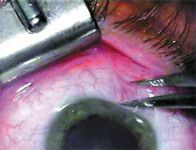Article
Cataract common complication of IVTA for DME
Las Vegas-When considering the use of intravitreal triamcinolone acetonide (IVTA) in patients with diabetic macular edema (DME), ophthalmologists should be mindful that cataract is a common complication and is particularly challenging in young patients with clear lenses and still-useful accommodation, according to a study reported by Moncef Khairallah, MD, here at the annual meeting of the American Academy of Ophthalmology.

Although research has shown IVTA to be effective in treating DME, other potential complications of its use include an increase in IOP and endophthalmitis, added Dr. Khairallah, professor of ophthalmology, Fattouma Bourguiba University Hospital, Monastir, Tunisia. He reported the results of a retrospective, nonrandomized, comparative trial of 104 eyes in 52 phakic patients who underwent unilateral IVTA for DME using one brand of the drug (Kenacort Retard, Bristol-Myers Squibb). The study aimed to determine the incidence of cataract after a follow-up of at least 12 months. Most previously reported studies had shorter follow-up periods, Dr. Khairallah said.

One researcher graded lens opacity via slit lamp examination using the Lens Opacities Classification System (LOCS) III. "Significant progression of cataract was defined as an increase of one or more LOCS III grades in one or more types of opacities: nuclear color and opalescence, cortical cataract, and posterior subcapsular cataract," he said.
Intravitreal injection of 4 mg of triamcinolone was performed under sterile conditions with subconjunctival anesthesia. The mean follow-up was 22 months (range, 12 to 48 months).
Follow-up results

"Poor glycemic control, as well as panretinal photocoagulation, might contribute to cataract formation in these [uninjected] eyes. To our knowledge, this finding has never been reported before," Dr. Khairallah said.
The mean time to cataract formation was 13 months in injected eyes and 21 months in uninjected eyes.
Previous studies had shown an incidence of cataract following IVTA ranging from 3.8% to 100% with a follow-up of 6 or more months, Dr. Khairallah said. "There are multiple possible reasons for the discrepancy" among studies, he added, "including variable sample sizes and the follow-up periods of these studies, retained definition for cataract formation or progression, and absence of standardization of clinical assessment of cataract."




